
6 minute read
Fruits of the Sea
Fish and abalone raised by Hawaiian aquaculture farms brighten the menus of the Four Seasons Resort Hualālai.
BY SHEILA GIBSON STOODLEY
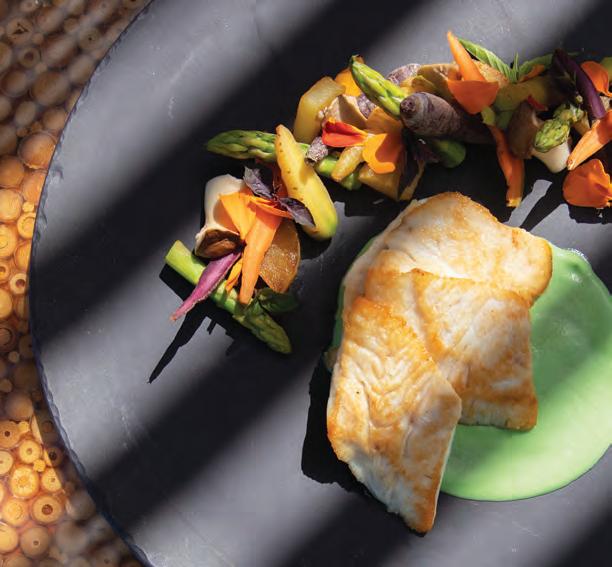
Before the resort’s chefs craft spellbinding dishes like Hualālai Grille’s Kona Kanpachi (top)—yellowtail pan seared with roasted Kamuela veggies and Wailua asparagus puree—Hawai‘i’s kanpachi and abalone farms work their own magic.
Photo: Anna Pacheco
Chef Richard Polhemus learned early that, with effort, abalone can make for an exceptional meal. One of his early culinary tasks was to prepare the mollusk’s meat in a Chinese style, with pork belly, Shaoxing wine, aromatics, and soy. “The dish was so luscious and satisfying,” he recalls, “and we used a really excellent Japanese abalone that needed time to braise and get tender.”
By contrast, the abalone from the Hawai‘i Island aquaculture farm Big Island Abalone didn’t require much, if any, preparation, and this instantly impressed Polhemus, who recently joined the Four Seasons Resort Hualālai as executive chef. “I was shocked at how fresh and tender the abalone was without any manipulation,” he says. “It’s also very good cooked, and we will be serving it as such, but we’ll also use it heavily in our sushi presentation.”
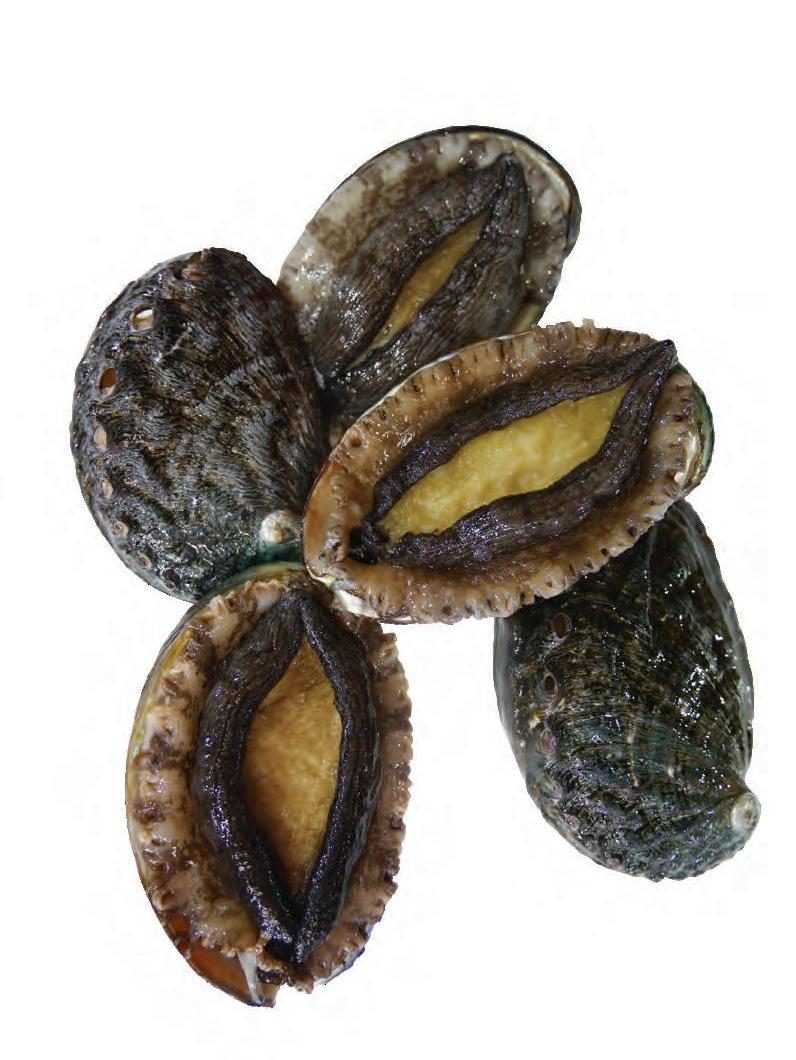
Big Island Abalone
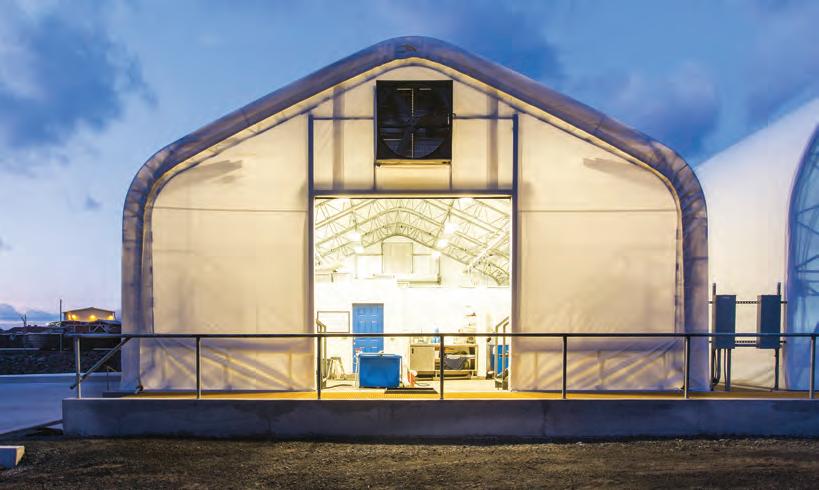
Hawaiian Kanpachi farm Blue Ocean Mariculture (below) produce their crops in Kailua-Kona, Hawai‘i, and are practically neighbors; they also share the same zip code with the Four Seasons Resort Hualālai, whose restaurants benefit from the ultrafresh bounty.
Photo: Anna Pacheco
In addition to abalone, the waters of Hawai‘i have proved ideal for farming a variety of exceptionally fresh seafood year-round. Polhemus and his team at the Four Seasons benefit from a bounty that includes oysters and shrimp raised on-site at the resort, as well as Hawaiian Kanpachi, a fish from the yellowtail family that is supplied by Blue Ocean Mariculture. Both Big Island Abalone and Blue Ocean Mariculture operate in Kailua-Kona, Hawai‘i, and are practically neighbors. Their products are, indeed, exceptionally fresh when you encounter them transformed into dishes at the restaurants at the Four Seasons: Both the aquaculture facilities and the resort reside in the same zip code.
Big Island Abalone’s aquaculture process takes place in a series of tanks on land. Of the operation’s 10 acres of farmland, about four acres are dedicated to feeding the abalone; the farm raises its own seaweed to help nourish its showcase product. “As long as we can get the abalone here, we have no reason to import,” says Polhemus, adding that chefs at Hualālai’s ‘Ulu Ocean Grill and Sushi Lounge are working wonders with the sea creature. “The product is so much fresher here, and not only that, it tastes cleaner. It must be the secluded ocean water.”
Over a span of three to four years, Big Island’s abalone advance from the hatchery to the intermediate tanks to the grow-out tanks. During site tours (unavailable temporarily due to the coronavirus pandemic), the first thing tourists see represents the last stage of the mollusks’ journey: the grow-out tanks. Small abalone, which tend to weigh in at 20 grams, are harvested at three years, while large abalone, which weigh about 120 grams, leave the water at around four years. At any given time, the company’s facility hosts about 400 million abalone (countable individuals excluding babies) at different stages of growth. And at every stage, the abalone benefit from bathing in cold seawater pumped from 3,000 feet below the surface of the ocean. “They prefer pure water,” says Satoshi Yoshida, chief operating officer of Big Island Abalone. “Moving water helps them breathe.”
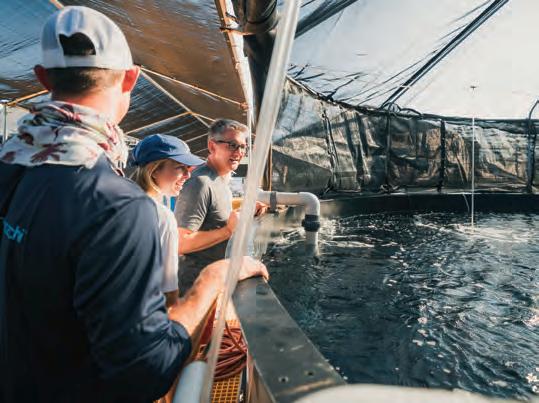
Photo: Andrew Hara

Photo: Andrew Hara
Like Big Island Abalone, the Blue Ocean Mariculture kanpachi farm relies on seawater drawn from the depths by the Natural Energy Laboratory of Hawai‘i Authority. David Valleau, Blue Ocean Mariculture’s vice president of sales, confirms that “the water is from the same pipe,” and the farm’s operations take place on land and in the sea. The younger fish develop in tanks for four months before moving to so-called cages that are visible from the shoreline. “If you’re flying out of Kailua-Kona and the cages are raised out of the water for servicing, harvesting, or feeding, you might see them,” says Valleau.
The fish at Blue Ocean Mariculture—generally a population of about a million—spend roughly a year in the cages and go to market once they reach five to seven pounds in weight. Valleau notes that the steady current flowing through the cages keeps the oxygen levels high and improves the flavor of the fish’s flesh by encouraging the fish to swim against it, building their muscles. “The water around the cages is just as clean as any part of the Hawaiian ocean,” he adds. “Our fish are healthy and grow to have as little impact on other species as possible.”
What distinguishes both Hawai‘i-based companies is their success with farming saltwater species. “A lot of aquaculture is built on freshwater fish,” says Valleau. “The challenge is to get saltwater fish to breed in captivity.” Blue Ocean Mariculture was the first to do this with a completely saltwater lifecycle, he says. The company obtained its brood stock, the source of its raw material, from local waters and refreshes it periodically. Big Island Abalone acquired its brood stock from Japan several years ago.
Polhemus estimates that the Four Seasons Resort Hualālai goes through 40 pounds of abalone and 350 pounds of Hawaiian Kanpachi per month. Like the abalone, the kanpachi proved an easy sell to the chef. “The fact that the brood stock is from local waters means that from nowhere else in the world will you get kanpachi that tastes like this or as good,” he says. “The quality is superb. The fish holds up well to so many cooking techniques; with a clean flavor, it can almost serve as a blank canvas. It works so well in all types of cuisine, and prepared raw— this is equally as special. Crudo will always be a staple at Beach Tree restaurant.”
For Polhemus, maintaining Hualālai’s commitment to locally sourced ingredients amounts to working not only with some of the planet’s finest crops but also with the talented people who cultivate them. “Working with local farmers, fishermen, and artisans has always been the best part of my job,” he says. “Having a sense of support for the community, and also working with some of the best produce and products in the world, keeps me and the team interested and passionate about what we do.”
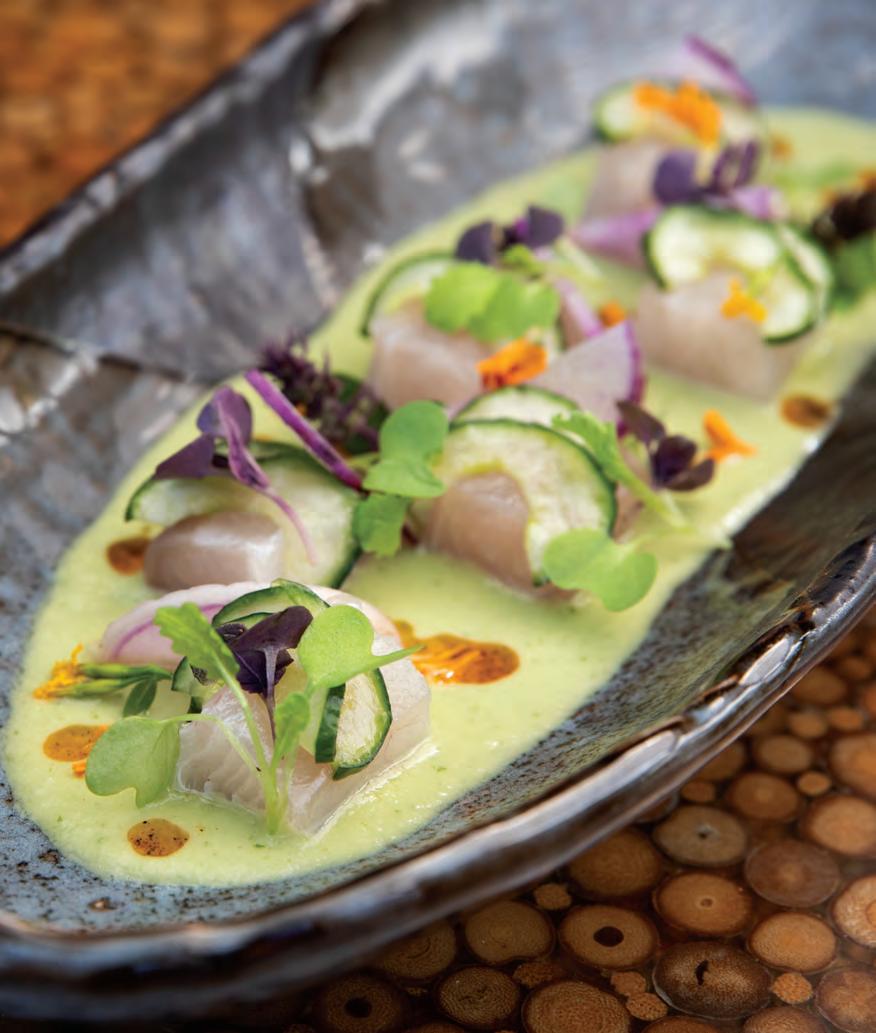
Hualālai Canoe Club’s Kanpachi Crudo
Photo: Anna Pacheco
RAW MATERIAL
Fish chosen for a world-class menu’s raw seafood crudo must be extraordinarily fresh and must taste great. For the crudo at the Four Seasons Resort Hualālai’s Beach Tree restaurant, executive chef Richard Polhemus’s choice is Hawaiian Kanpachi. “The flavor is very clean and almost meaty,” he says of the yellowtail fish. “It’s somewhat dense but always moist and has the best fat content of any fish I’ve tried.”
Beach Tree’s patrons like it, too. “I think the combination of clean, briny flavor with a firm and juicy texture is what guests really enjoy about this kanpachi,” notes Polhemus. No doubt, they’ll also delight in his latest take on a fan favorite: “We plan to garnish the Kanpachi Crudo with a passionfruit vinaigrette— made with passionfruit from our garden—and some Big Island hearts of palm, both roasted and raw,” he says. “And we’ll finish the dish with black truffle to add some earthiness.” —S.G.S.






